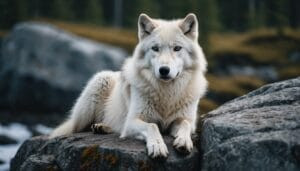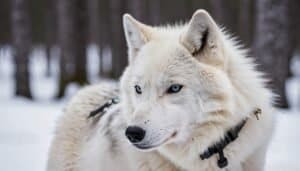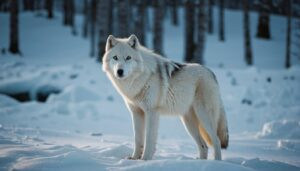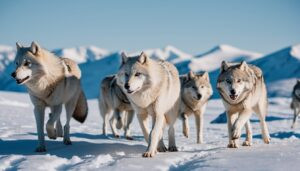Introduction
Scientists utilize a variety of advanced technologies and field research methods to track and monitor Arctic wolf populations. This article explores the tools and techniques used in tracking, the types of data collected, and the challenges faced in these efforts
Technologies and Methods for Tracking Arctic Wolves
To effectively monitor and track Arctic wolf populations, scientists employ a combination of advanced technologies and traditional field research methods
These tools and techniques provide critical data on the wolves’ movements, behaviors, and population dynamics, contributing to conservation and management efforts
GPS Tracking and Collars
One of the primary technologies used in tracking Arctic wolves is GPS collars. These collars are equipped with GPS devices that transmit location data at regular intervals
Scientists attach these collars to wolves through a safe and humane process, often involving tranquilizers administered by experienced wildlife biologists. The GPS data collected provides detailed information on the wolves’ movements, home range, and migration patterns
The data from GPS collars allows researchers to analyze how Arctic wolves navigate their harsh environment, locate prey, and interact with other wolves. This information is crucial for understanding their spatial ecology and for making informed decisions about their conservation
For instance, tracking data has revealed that Arctic wolves can travel up to 30 miles a day, demonstrating their vast territorial needs and the importance of preserving large, contiguous habitats
Satellite Imaging and Remote Sensing
Satellite imaging and remote sensing technologies play a significant role in monitoring Arctic wolf populations. High-resolution satellite images help scientists observe changes in the wolves’ habitat, such as ice melt, vegetation cover, and human encroachment
These images are invaluable for tracking environmental changes that impact wolf populations and for identifying potential new habitats
Remote sensing technology also assists in monitoring the wolves’ movements over large, inaccessible areas. By analyzing satellite data, researchers can identify travel corridors and critical habitats, providing insights into how Arctic wolves adapt to changing conditions
This technology has been particularly useful in studying the effects of climate change on Arctic ecosystems and their inhabitants
Radio Telemetry
Radio telemetry is another effective method for tracking Arctic wolves. This technique involves fitting wolves with radio collars that emit signals tracked by researchers using portable receivers
Unlike GPS collars, which provide precise location data, radio telemetry offers more general location information but is valuable in regions where GPS signal coverage is limited
Researchers often use radio telemetry in conjunction with GPS tracking to gather comprehensive data. The combination of these methods allows for continuous monitoring of wolf movements and helps fill gaps in GPS data
Radio telemetry is also useful in densely vegetated areas where GPS signals may be obstructed, ensuring scientists can track wolves across diverse landscapes
Direct Observation and Surveys
Field surveys and direct observation remain essential components of Arctic wolf monitoring. Scientists conduct regular expeditions to observe wolves in their natural habitat, recording behaviors, interactions, and physical conditions
These surveys often involve tracking wolves by following their footprints, scat, and other signs, providing valuable insights into their daily activities and social structures
Direct observation allows researchers to collect qualitative data that complements the quantitative data from technological methods. For example, observing pack dynamics and hunting strategies helps scientists understand the wolves’ social behaviors and their roles within the ecosystem
These field surveys are critical for validating and interpreting data from GPS collars and radio telemetry
Camera Traps and Remote Monitoring
Camera traps are widely used in wildlife research, including monitoring Arctic wolves
These motion-activated cameras capture images and videos of wolves as they pass by, providing visual evidence of their presence and activities. Camera traps are strategically placed along known travel routes, den sites, and hunting grounds to maximize the likelihood of capturing wolf footage
Remote monitoring through camera traps offers several advantages. It allows for non-invasive observation of wolves, reducing the risk of disturbing their natural behaviors. The images and videos collected provide data on wolf population size, pack composition, and reproductive success
Additionally, camera traps can operate in harsh weather conditions and remote locations, making them ideal for Arctic environments
Sample Collection and Analysis
Collecting and analyzing biological samples is another crucial method for monitoring Arctic wolves. Researchers collect samples such as fur, scat, and blood to study genetic diversity, diet, and health status
Genetic analysis of fur and scat samples helps scientists understand population structure, relatedness among individuals, and gene flow between packs
Diet analysis through scat examination reveals the wolves’ prey preferences and hunting success, providing insights into their ecological role. Health assessments from blood samples indicate the presence of diseases and parasites, informing conservation strategies to maintain healthy wolf populations
These biological samples are often collected during field surveys or from captured wolves fitted with GPS or radio collars
By combining these advanced technologies and traditional field methods, scientists can gain a comprehensive understanding of Arctic wolf populations, informing conservation efforts and ensuring the survival of these iconic predators in their fragile Arctic habitat
Data Collection and Analysis of Arctic Wolves
Collecting and analyzing data on Arctic wolves is essential for understanding their ecology, behavior, and population dynamics
This information helps scientists develop effective conservation strategies and manage wolf populations sustainably. Various methods are employed to gather and interpret data, providing a comprehensive picture of Arctic wolf life
Tracking Movements and Migration Patterns
One of the primary objectives in tracking Arctic wolves is to understand their movements and migration patterns. GPS collars and radio telemetry provide detailed data on the distances wolves travel, their home ranges, and seasonal migration routes
Analyzing this data helps scientists identify critical habitats and travel corridors essential for wolf survival
Studies have shown that Arctic wolves can cover vast distances, sometimes traveling over 500 miles in a single migration season. This extensive movement is often driven by the need to follow migrating prey such as caribou
By mapping these movements, researchers can pinpoint areas that are crucial for conservation efforts, ensuring that wolves have access to the resources they need throughout the year
Studying Behavior and Social Structure
Behavioral studies are a key component of Arctic wolf research. By observing wolves in their natural habitat and analyzing data from GPS collars, camera traps, and field surveys, scientists gain insights into their social structure, hunting strategies, and interactions within packs
Arctic wolves are known for their complex social behaviors. Packs are typically composed of a dominant breeding pair and their offspring, but pack dynamics can vary
Observations have revealed that wolves often exhibit cooperative hunting behaviors, which are essential for taking down large prey like musk oxen and caribou. Understanding these social interactions helps researchers predict how wolf populations will respond to environmental changes and management interventions
Assessing Health and Population Dynamics
Monitoring the health and population dynamics of Arctic wolves involves collecting and analyzing biological samples, population counts, and health assessments. Blood samples, scat, and fur collected from wolves provide information on their diet, genetic diversity, and health status
Genetic analysis helps scientists understand the genetic diversity within and between wolf populations. High genetic diversity is crucial for the long-term survival of the species, as it enhances their ability to adapt to changing environments and resist diseases
Health assessments, including the detection of parasites and diseases, inform conservation strategies aimed at maintaining healthy wolf populations
Population counts are conducted through aerial surveys, camera trap data, and field observations. These counts help estimate population sizes and track changes over time. Understanding population dynamics, including birth rates, mortality rates, and dispersal patterns, is vital for managing wolf populations and ensuring their sustainability
Combining these data collection and analysis methods allows scientists to build a detailed understanding of Arctic wolf populations. This comprehensive approach informs conservation strategies, ensuring that these iconic predators continue to thrive in their Arctic habitat
Challenges and Considerations in Tracking Arctic Wolves
Tracking Arctic wolves presents numerous challenges and requires careful consideration of ethical and safety concerns. Scientists must navigate harsh environmental conditions, overcome technological limitations, and ensure that their research methods do not harm the wolves or their habitat
Addressing these challenges is essential for the successful monitoring and conservation of Arctic wolf populations
Environmental and Weather Conditions
The Arctic environment poses significant challenges for tracking and monitoring wolves. Extreme cold, high winds, and heavy snowfall can hinder fieldwork and damage equipment. Researchers often face logistical difficulties in accessing remote areas, especially during winter when temperatures can plummet below -40°F
Weather conditions also affect the reliability of GPS signals and radio telemetry. Snow and ice can obstruct signals, leading to gaps in data collection. To mitigate these issues, scientists schedule fieldwork during more favorable weather conditions and use equipment designed to withstand extreme cold
Additionally, data from multiple sources, such as satellite imagery and camera traps, are combined to provide a comprehensive picture despite these challenges
Technological Limitations
While GPS collars and radio telemetry are invaluable tools, they come with limitations. GPS collars can fail due to battery depletion, mechanical issues, or environmental interference. Radio telemetry provides less precise location data compared to GPS and requires researchers to be within a certain range to pick up signals
To address these limitations, scientists use a combination of tracking technologies to ensure data continuity. For instance, when GPS collars fail, radio telemetry can still provide general location information. Researchers also frequently check and maintain equipment to ensure optimal performance and extend the lifespan of tracking devices.
Ethical and Safety Concerns
Ethical considerations are paramount in wildlife research, and tracking Arctic wolves is no exception. Scientists must ensure that their methods do not harm the wolves or disrupt their natural behaviors. Attaching GPS collars, for example, requires capturing and handling wolves, which can cause stress and pose risks if not done correctly
To minimize these impacts, researchers follow strict guidelines and use humane techniques for capturing and handling wolves. Tranquilizers are administered by trained professionals to reduce stress during collaring. Additionally, collars are designed to be lightweight and fitted properly to avoid discomfort or injury
Safety concerns extend to the researchers as well. Working in the Arctic can be dangerous due to the extreme conditions and potential encounters with other wildlife. Researchers undergo rigorous training in wilderness survival, first aid, and safe handling of wildlife to ensure their safety and the success of their missions
Addressing these challenges requires a careful balance between scientific inquiry and ethical responsibility. By continuously improving methodologies and technologies, scientists can effectively track Arctic wolves while ensuring the welfare of both the wolves and the researchers
Conclusion
Tracking and monitoring Arctic wolf populations involve a combination of advanced technologies and traditional field research methods
Scientists use GPS collars, satellite imaging, radio telemetry, direct observation, camera traps, and biological sample collection to gather comprehensive data on wolf movements, behavior, health, and population dynamics. Despite the numerous challenges posed by the harsh Arctic environment, technological limitations, and ethical considerations, researchers strive to ensure that their methods are effective and humane
This detailed understanding of Arctic wolves is crucial for developing informed conservation strategies that support the sustainability of these iconic predators in their fragile habitat. By continuously adapting and improving their techniques, scientists contribute to the ongoing efforts to protect and preserve Arctic wolf populations for future generations











